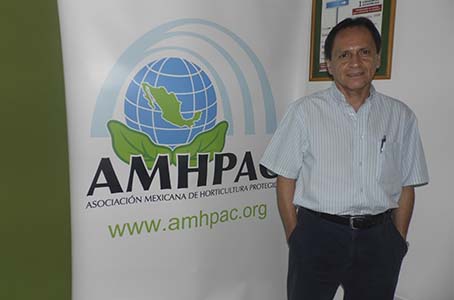Interview: Alfredo Diaz Belmontes CEO of the Asociación Mexicana de Horticultura Protegida

We had the pleasure to interviewed Alfredo Díaz Belmontes, an Agronomist from Guamúchil, Sinaloa, graduated from Tecnológico de Monterrey, and with a master degree oriented to agricultural economy of the University of California, Davis.
His love for agriculture combined with his interest in the social sciences, guided Alfredo Díaz along a path full of learning and new experiences, allowing him to become nowadays the Director of the Asociación Mexicana de Horticultura Protegida, refreshing the scheme the organism and always looking for the benefit of each one of its members.
- Could you tell us a little about your professional experience?
I am part of a family of farmers so as long as I can remember I use to go to the fields all the time; it was no problem for me to decide what degree study. When I was in college, I used to came to Sinaloa in summers and worked in the field of my family paying all those people who worked as cotton pickers.
When I finished my career and my master degree, I returned to Mexico searching for a job. Back then I was very interested in the public area and got a job in an organism named Servicios Ejidales (SERSE), where I coordinated a small interdisciplinary group of professionals and we evaluated agribusiness projects.
After that, I got a job in the central administration of the Federal Government, at the Secretaría de Programación y Presupuesto, predecessor of SEDESOL, in Baja California. It was a nice experience, professionally speaking: I was involved in a group of professionals and we used to write at the local newspaper, we conducted various research programs, I started my career as a teacher, among other things. Then, in Baja California, I joined the Banco Nacional de Obras y Servicios Públicos (Banobras), a Federal Government organization that meet the needs of the agricultural sector. For me this was an excellent school because the lending process is so extensive that one has to play the role of engineer, financial, politician, etc.
When I left BANOBRAS I decided to devote time to the family business, and even dabbled in several projects with other partners, that was when I started teaching at the Tec de Monterrey Culiacan. In 2010 I returned to the public sector as Northwest Regional Director of Agencia de Servicios a la Comercialización y Desarrollo de Mercados Agropecuarios (ASERCA); It was an intense experience because of the constant travel between Sonora, Baja California and Sinaloa. Then in 2012 I was invited to lead the delegation of the Secretaria de Desarrollo Social (SEDESOL) here in Sinaloa.
In 2013 I joined AMHPAC, and I also kept attending personal business and parallel to this I continued teaching, because I think I learn a lot from my students.
What’s the main purpose of the AMHPAC?
A visionary group of producers, led mostly by Cesar Campaña, had the idea to pick up on what was the Asociación Mexicana de Productores de Invernadero (AMPI), in order to become an union of members and to provide benefits that would improve their business.
Being a relatively young agency, with eight years, it grew exponentially during the early years, both in number of members as in number of hectares of production under protected schemes, and currently it have more than 200 members in 24 states here in Mexico.
Been Sinaloa an icon of Mexican horticulture, it was determined that the headquarters were here in Culiacán, and from here we coordinate our work and communicate with all our affiliates who join under different schemes: horticultural producers who produce in a protected way, as sponsor all those suppliers for the horticultural sector, and finally, we have the signer figure, which was created with the aim of provide producers of tomato specifically the opportunity to adhere to the dumping suspension agreement.
Personally I think we all need someone to represent us, not only in good but in bad cases too. For example, in the case of dumping, one producer could not defend themselves against the blame, but unionized the defense is much more solid
2. What are some benefits of protected horticulture?
As the name implies, this practice consists in protecting crops with anything, from greenhouses to highly sophisticated and high-tech equipment; and although “Sinaloa is a natural greenhouse” in winter, issues such as climate change have made us start using such systems.
So, first of all we protect against the weather but also against pests, diseases and all those factors that may affect our product. By doing these, we may even have a more efficient use of water, get a five times higher performance, and above all, the product quality is much higher. For all these reasons, protected production schemes became very popular and more and more producers will use it in the future. Here in Mexico the trend of increase is 1,200 hectares per year.
3. Being a national organism, what perception do you think people from other states have of Sinaloa as a producer?
Sinaloa’s the most important agricultural state in the country, no doubt, and the numbers prove it. Of 9,00 protected hectares that are registered in AMHPAC, a little more than 4,500 hectares are from Sinaloa.
We continue being spearhead in production, quality, technological advancement; we are excellent producers and will remain as it but personally, I think it’s time to add value to our product.
4. Because of your experience, ¿how do you perceive the evolution of the use of technology in Mexican agriculture?
Technology has evolved very fast and, as I mentioned above, the use of protected systems increases 1,200 hectares per year in our country. Different sophisticated high-tech systems are developed steadily and we have to be very careful, and above all, take these developments because we can fall behind very easily.
The agricultural sector is very diverse not only in geographical regions but in climates, idiosyncrasies, etc. We have a northern country that is more developed in many ways, a center of that’s very diverse and a southern zone that’s further behind.
And within agriculture in general we have horticultural production, which can be considered as the elite activity, and then we have protected horticulture that’s even more technical and most of the producers are in favor of the adoption of technology, I can assure you that because it is something that I see and live every day.
5. Could you tell us a little more about all the projects that AMHPAC is working on?
I always tell to my team of work that is very necessary to realize a self-evaluation and oxygenate what we are doing. That’s what we did in AMHPAC and as a result we determined five pillars that have guided us in recent years: planning, technological innovation, added value, crop diversification and new markets. We call this “AMHPAC concept”.
First of all, I consider it necessary to plan to get better results, of course all depending on what the markets are demanding and not the other way. In order to plan we need information and AMHPAC took on the task of building a platform containing everything producers need to know: what are the products that are demanded, how much they coast, what characteristics are requested, etc. I know it sounds like an utopia, but we’re trying. So far we have completed the first stage, which we call “content platform”, and we have temporarily released it to the public, it can be found on our website: www.amhpac.org. We are also working on an app for smartphones which we intend to launch during the conferences.
Moreover, talking about technological innovation, to support our members in this area we have woven alliances with two major organizations: the Centro de Investigación en Alimentación y Desarrollo (CIAD) and the Tecnológico de Monterrey. Recently asked Proméxico for an analysis of new markets, as a result they told us about 6 countries, mostly in Europe and Russia, with unmet demand of vegetables. For example, the study found out that there is a demand for fresh tomatoes for 100 billion in these countries, but it is for $ 350 million in tomato paste, conclusion: you have to make tomato paste. As AMHPAC, we will support in all the matters relating to the implementation of business plans and the CIAD meanwhile, pledged to build on the technical side.
In addition to all this, we’re working on a training program that we’re providing throughout the year, in different parts of the country. We talked about it to our sponsors and we proposed to them the idea of giving regional forums for training together and thus allow everyone involved to benefit from this initiative.
Working on all these pillars, we make it clear to our partners that it is necessary to plan according to the information we have, to add value to what we already do and not pigeonhole not a single product or a single market, we must remember that globalization has allowed competition to get stronger. This organism will continue working to give all its members the best tools.
6. What awaits us in the 2015 AMHPAC Congress?
Personally, I am very excited. Two years ago we changed the model of the congress, which was performed steadily in Guadalajara, and moved it for the first time to Puerto Vallarta, and against all odds we did pretty well; a year later we held it in Los Cabos, and again we were a blast. This year, as a result of surveys of participants, we have decided to return to Puerto Vallarta.
I believe that we need to refresh the concept every year, and with this in mind we timetabled simultaneous conferences, putting together a very attractive program that will result in a lot of learning, due to the quality of the speakers and topics. For example, there’ll be a panel about organic products with the opinion of producers, traders and seed suppliers, a panel of social responsibility, an issue that belongs to us all, a panel on insurance, plus many more technical and business conferences that are equally interesting.
Complementing all these we will have business tables between producers and buyers from the US and Canada and others between producers and Mexican banks, who have had a good relationship with AMHPAC in the past few years and have shown interest in playing credit issues with our partners .
In addition we will have recreational activities: the first day we have plan a retro dinner and the second day we have a dinner on a pirate ship. Finally it takes place the celebration of the annual meeting of our board.
The idea, in the end, is that all us go in a relaxed atmosphere and learn a lot, above all, to do business and to achieve this integration we always look, because we are all a guild and we must consolidate it.


